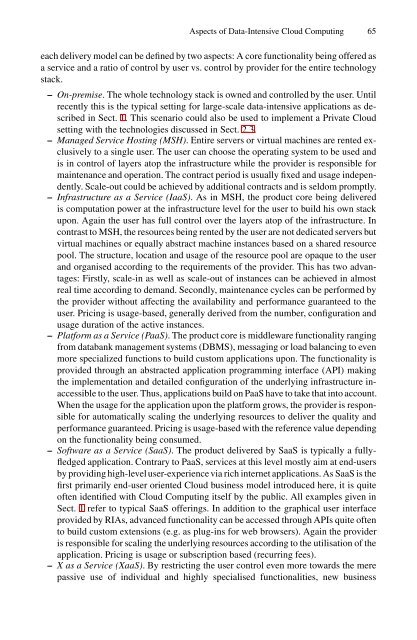Aspects of Data-Intensive Cloud Computing - DVS - Technische ...
Aspects of Data-Intensive Cloud Computing - DVS - Technische ...
Aspects of Data-Intensive Cloud Computing - DVS - Technische ...
Create successful ePaper yourself
Turn your PDF publications into a flip-book with our unique Google optimized e-Paper software.
<strong>Aspects</strong> <strong>of</strong> <strong>Data</strong>-<strong>Intensive</strong> <strong>Cloud</strong> <strong>Computing</strong> 65<br />
each delivery model can be defined by two aspects: A core functionality being <strong>of</strong>fered as<br />
a service and a ratio <strong>of</strong> control by user vs. control by provider for the entire technology<br />
stack.<br />
– On-premise. The whole technology stack is owned and controlled by the user. Until<br />
recently this is the typical setting for large-scale data-intensive applications as described<br />
in Sect. 1. This scenario could also be used to implement a Private <strong>Cloud</strong><br />
setting with the technologies discussed in Sect. 2.3.<br />
– Managed Service Hosting (MSH). Entire servers or virtual machines are rented exclusively<br />
to a single user. The user can choose the operating system to be used and<br />
is in control <strong>of</strong> layers atop the infrastructure while the provider is responsible for<br />
maintenance and operation. The contract period is usually fixed and usage independently.<br />
Scale-out could be achieved by additional contracts and is seldom promptly.<br />
– Infrastructure as a Service (IaaS). As in MSH, the product core being delivered<br />
is computation power at the infrastructure level for the user to build his own stack<br />
upon. Again the user has full control over the layers atop <strong>of</strong> the infrastructure. In<br />
contrast to MSH, the resources being rented by the user are not dedicated servers but<br />
virtual machines or equally abstract machine instances based on a shared resource<br />
pool. The structure, location and usage <strong>of</strong> the resource pool are opaque to the user<br />
and organised according to the requirements <strong>of</strong> the provider. This has two advantages:<br />
Firstly, scale-in as well as scale-out <strong>of</strong> instances can be achieved in almost<br />
real time according to demand. Secondly, maintenance cycles can be performed by<br />
the provider without affecting the availability and performance guaranteed to the<br />
user. Pricing is usage-based, generally derived from the number, configuration and<br />
usage duration <strong>of</strong> the active instances.<br />
– Platform as a Service (PaaS). The product core is middleware functionality ranging<br />
from databank management systems (DBMS), messaging or load balancing to even<br />
more specialized functions to build custom applications upon. The functionality is<br />
provided through an abstracted application programming interface (API) making<br />
the implementation and detailed configuration <strong>of</strong> the underlying infrastructure inaccessible<br />
to the user. Thus, applications build on PaaS have to take that into account.<br />
When the usage for the application upon the platform grows, the provider is responsible<br />
for automatically scaling the underlying resources to deliver the quality and<br />
performance guaranteed. Pricing is usage-based with the reference value depending<br />
on the functionality being consumed.<br />
– S<strong>of</strong>tware as a Service (SaaS). The product delivered by SaaS is typically a fullyfledged<br />
application. Contrary to PaaS, services at this level mostly aim at end-users<br />
by providing high-level user-experience via rich internet applications. As SaaS is the<br />
first primarily end-user oriented <strong>Cloud</strong> business model introduced here, it is quite<br />
<strong>of</strong>ten identified with <strong>Cloud</strong> <strong>Computing</strong> itself by the public. All examples given in<br />
Sect. 1 refer to typical SaaS <strong>of</strong>ferings. In addition to the graphical user interface<br />
provided by RIAs, advanced functionality can be accessed through APIs quite <strong>of</strong>ten<br />
to build custom extensions (e.g. as plug-ins for web browsers). Again the provider<br />
is responsible for scaling the underlying resources according to the utilisation <strong>of</strong> the<br />
application. Pricing is usage or subscription based (recurring fees).<br />
– X as a Service (XaaS). By restricting the user control even more towards the mere<br />
passive use <strong>of</strong> individual and highly specialised functionalities, new business















